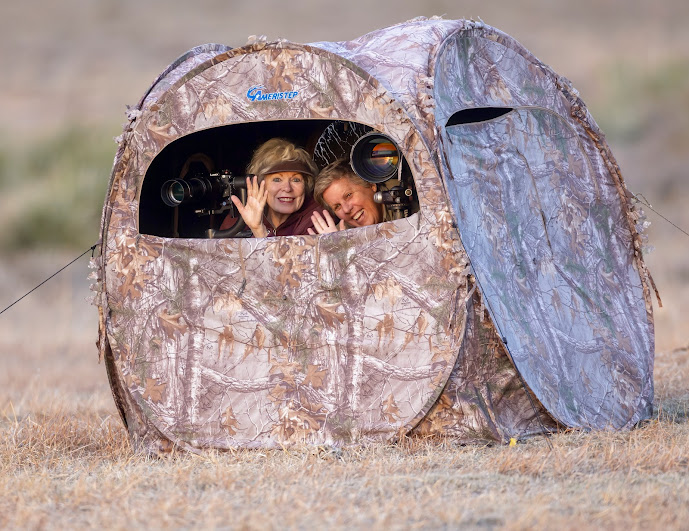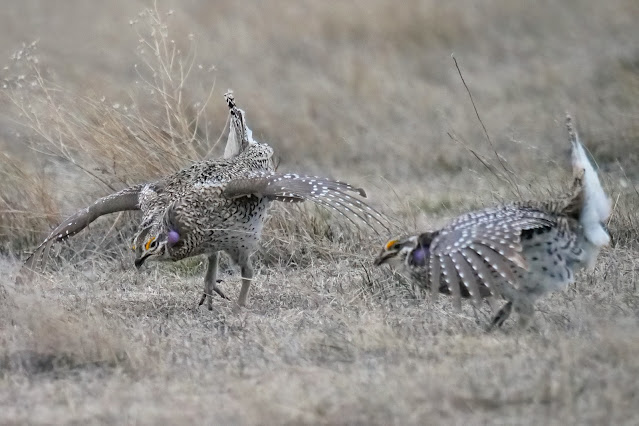Photo credit: David Bates
Early morning in mid-April found us
on a Colorado mating lek of a pack of Greater Prairie Chickens (Tympanuchus
cupido). There is something special about the busyness
and noises of the lek that keeps us coming back in the springtime. Listen to the booming sounds and clucking of
the prairie chickens as you watch this early morning video. You might even hear
the pounding of their feet as the males prepare to fill their gular sacs, bow,
and boom.
Yes, Greater Prairie Chickens (GPC) do fly. Not only are they prolific jumpers and sparing experts, but they can also fly at speeds of up to 50 mph, as we saw when it was time for them to leave the mating lek. Like other grouse we have seen, the GPC leave the lek in a pack and seemingly all at once, maybe upon the signal of a lead GPC, though that is not always evident. They will leave the lek temporarily, if they suspect danger lurks such as a circling hawk or a prowling coyote. Once the perceived danger retreats, the GPC will return to the lek to continue their mating rituals until they declare it time to leave for the day. They left the lek closer to 8 am this year. As we found on this trip, they do return to the mating lek in the evening with the setting sun, which made for some interesting backlit photographic opportunities.


This year, we were more familiar with the grouse mating routine and could concentrate on predicting the actual behavior pattern. This was useful when trying to be camera ready for the frenzied displays between the males and the rapid copulation act between the male and the hen.

|
The
males circle each other with various bowing actions, constantly
chattering as if to threaten their counterpart. Watching the pinnae
feathers is important. These long feathers at the neck rise up straight
when the male is ready for jousting action. Once a sparring partner is
engaged, the two will lower their wings near the ground, bring their
tail feathers forward to their bodies and shake them. Then one of the
birds will jump up high in the air to attack the other in a show of
dominance. This might be repeated several times before the two split
apart and go back to filling their orange gular sacs with air, releasing
the air making a loud booming sound, and stomping their feet rapidly as
they turn around.
| | |
|
|
|
|
|
|
|
|
|
|
|
|







Single males also practice jumping in the air, booming,
foot stomping, and clucking vocalization.
We found that you could tell when a male was ready to jump, because he
stretches his neck while looking skyward, twists around a bit, and then leaps
into the air, landing several feet away.
Sometimes he performs this act repeatedly across several feet of the
lek. Other times, he seems to take a
breath and returns to booming.
Competition for prime lek placement was evident this year,
too. The stronger males take center
stage as do the hens. The younger males
stay to the periphery, venturing closer to the center only when jumping and
sometimes crossing over into the center when in full flight sparing action.
Once the birds left the lek, we could see the full lek and
its stark location with short grasses filling in around the sandy patches. Feathers, bird fecal droppings, and stomping
tracks remained the only evidence that a spectacular ritual had only just
finished on this very spot.
We will be back for more of these fascinating dancers.




























Another great experience with Christine!
ReplyDeleteI really enjoy your adventures while documenting the wildlife out here on the prairie lands! Wonderful photos ladies!!
ReplyDeleteThanks so much for following along with us. We still have much to learn and experience.
Delete